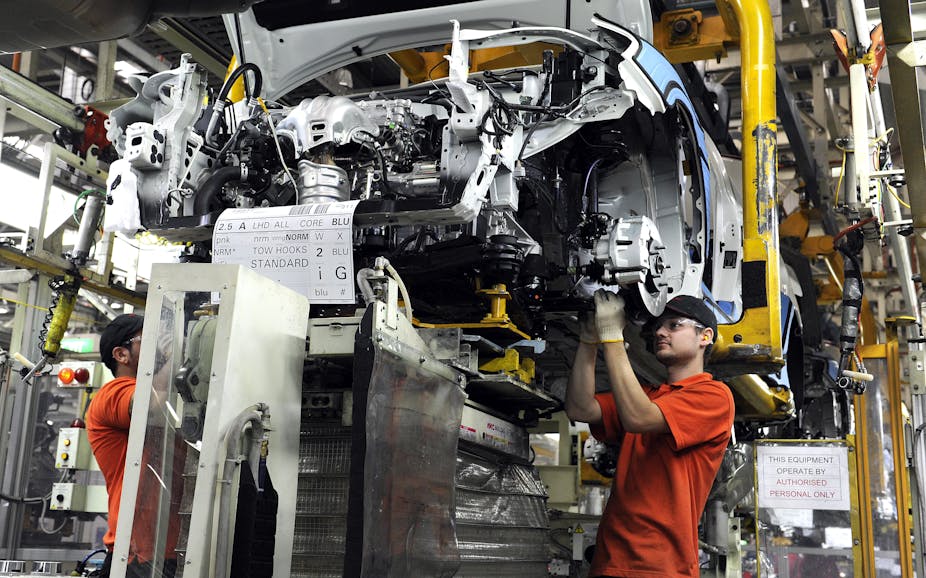The Conversation asked two experts in South Australian and Victorian politics to comment on the political repercussions of Toyota’s decision to cease making cars in Australia – marking the end of car manufacturing in Australia – as both states, the (soon-to-be former) homes to Australia’s auto industry, gear up to go to the polls this year.
Approximately 2500 Toyota jobs will be lost in Victoria, with fears of tens of thousands of job losses from supporting industries. Victorian premier Denis Napthine is seeking an “adjustment package” from prime minister Tony Abbott.
In South Australia, auto suppliers are expected to be hit hard by the end of car manufacturing in Australia, with the 12,000 job losses caused by the planned closure of Holden in 2017 to multiply to 16,000.
South Australia
John Spoehr, Executive Director of the Australian Workplace Innovation and Social Research Centre at the University of Adelaide
Could the collapse of the car manufacturing industry give South Australian Labor a fourth term when the state goes to the polls on March 15?
There is no doubt that recriminations over who is to blame for the collapse of the Australian automotive industry will play out in the South Australian and Victorian state elections. The scale of the job losses makes this inevitable, as does the hardline position taken on industry assistance by the Abbott government.
Prime minister Tony Abbott and treasurer Joe Hockey have made it clear that they have no appetite for continued assistance to the automotive sector. The auto industry has called their bluff. One by one they have announced closure plans. This is the worst possible news for the workers, families and businesses affected. It will have to play on their minds in polling booths.
The scale of the automotive industry crisis is sobering. Around 45,000 direct and a further 100,000 indirect jobs are impacted. Communities already struggling with high unemployment in northern Adelaide, western Sydney and Melbourne cannot absorb a shock like this.
Central to the debate over the weeks to come will be whether or not the federal government could have prevented or at least delayed some of the closures. Also in play will be the adequacy of the assistance packages it is willing to provide to South Australia, Victoria and New South Wales.
The initial assistance offer from the federal government is just A$60million. To put this in perspective, the losses associated with the collapse of the industry are likely to be in excess of $10 billion. State governments are already insisting that the national government deliver hundreds rather than tens of millions to the recovery effort.
South Australian premier Jay Weatherill and his Victorian counterpart, Denis Napthine, are making it clear to the federal government that more will need to be done.
Many are likely to see the federal government’s hardline position of denying further assistance to the industry as a major contributor to the industry’s collapse. This no doubt will be one of the key messages the Labor government in South Australia will use in the campaign ahead. It is a message that has the potential to erode the electoral advantage currently being enjoyed by the Liberal opposition.
There is a chance that the collapse of the Australian automotive industry might deliver a fourth term to the South Australian Labor government. At the very least, it could contain some of the losses.
Victoria
Zareh Ghazarian, Lecturer, School of Political and Social Inquiry at Monash University
The news is particularly grim for Victoria, a state that has a proud history of manufacturing.
While debates will continue about the business decisions made by the car companies, especially about their responsiveness to market demands, the political ramifications of the industry’s demise are amplified in an election year. Victorians will be going to the polls on November 29.

The Coalition government already has a shaky hold on power. Ted Baillieu led the Coalition to victory in 2010 with a majority of just one seat. In recent months, the Coalition’s authority has been tested by the actions of MP Geoff Shaw, whose resignation from the parliamentary Liberal Party was integral to Baillieu’s downfall in 2013.
Shaw has voted with the opposition on several occasions. This has not only frustrated Denis Napthine (Baillieu’s replacement as premier), but it has also made the government appear disorganised.
Within this context, the Coalition has seemed unable to assert its dominance over the political debate. Opinion polls have reflected the government’s brittle support, with Labor appearing to be in an election-winning position.
A significant problem for the Victorian government now is that it appears to be distracted by internal machinations while the state’s manufacturing sector crumbles. Napthine has tried to be seen as being proactive. He will be meeting with the federal government today to seek assistance packages for Toyota workers, and prime minister Tony Abbott has indicated he is open to further federal funding.
This, however, may not placate the workers whose livelihoods will be affected by Toyota’s decision. It may also not be not be enough to ensure that voters see the Victorian government in a more positive light.
On the other hand, the Labor opposition, led by Daniel Andrews, will be able to use Toyota’s decision as yet another political weapon against the government. It will fit neatly into the broader narrative the opposition has constructed about the government appearing to be ineffective and weak. Victorian Labor looks well placed to benefit electorally from the end of car manufacturing.
The decision of the car makers will leave significant economic holes in the Victorian economy. In a political sense, however, the decision will work to strengthen the opposition’s run to the polls while contributing to the sense that the Napthine government has been unable to manage the political debate.

